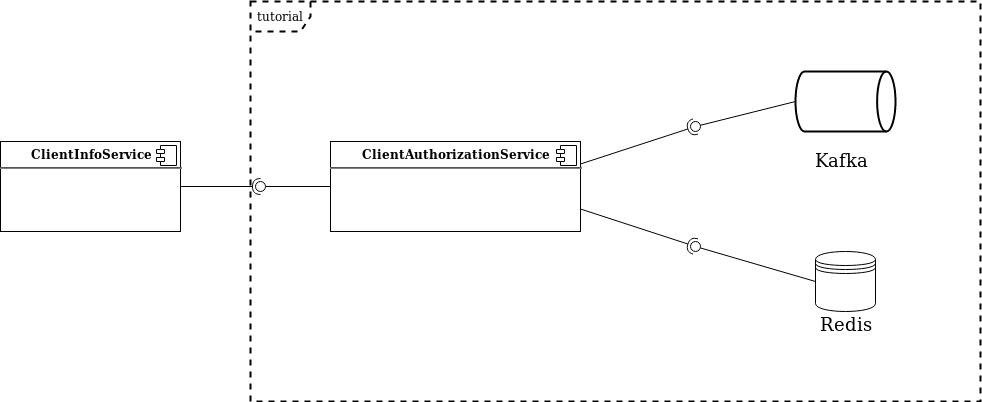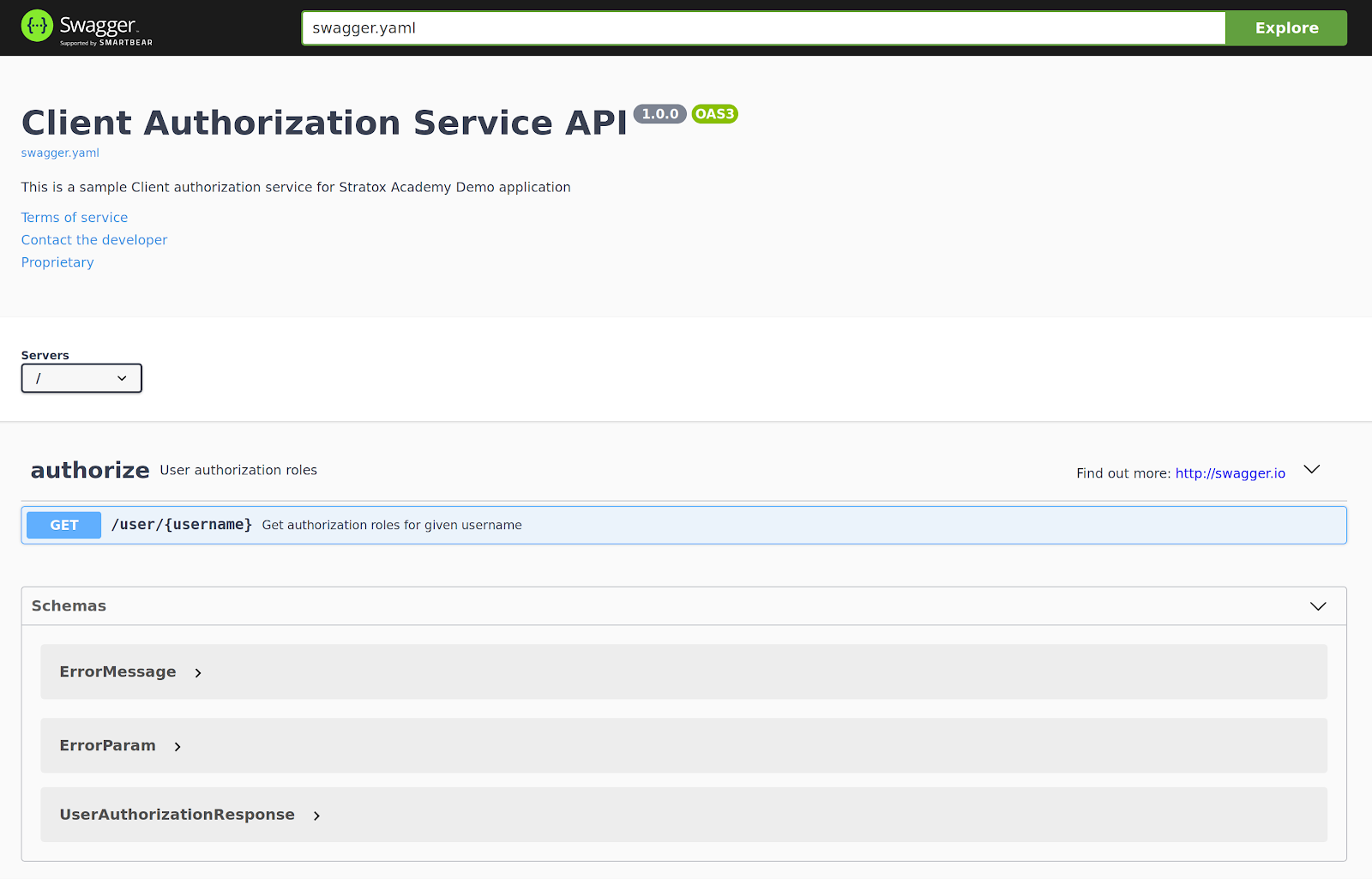Java Micronaut REST Server with Redis and Kafka
🕓 40 minutes
What you’ll learn
How to set up your application for :
- connecting to Redis,
- connecting to Kafka and publishing messages to its topic,
- getting data from REST API,
- providing data to REST API.
In this tutorial, we will create a simple java component with the Java Micronaut scaffolder. We want to expose a single REST endpoint for getting user authorization roles. As roles are stored in Redis key-value store, we need a client configuration for our component. Any access to information about user roles should be logged in a Kafka topic, so we need a Kafka client configuration too.

Project source
This example project can be cloned from: http://gitlab.cloud.codenow.com/public-docs/client-authorization-demo/client-authorization-service.git
Prerequisites
- Prepare your local development environment for CodeNOW with Micronaut.
- Follow the tutorial instructions in the Java Micronaut Local Development tutorial.
- Run Kafka and Redis locally.
- You can run Kafka and Redis directly or using docker compose.
- Configuration files for docker-compose for both Kafka and Redis can be downloaded from the link that can be found in the section Docker compose and third-party tools of the Java Micronaut Local Development tutorial.
- Create a new component
- For details see the section Prerequisites of the Java Micronaut Local Development tutorial.
Steps
Open your IDE, import created component and start coding:
-
Define message payload. Here is an example of
UserAuthorizationResponse, which is a simple POJO with user roles:- generate getters and setters with your IDE
package io.codenow.client.authorization.service.model;
import java.util.Set;
public class UserAuthorizationResponse {
private Set<String> roles;
} -
Next prepare the configuration for the kafka logging client:
-
Go to the Kafka administration console (http://localhost:9000 if using kafdrop from our Local development manual) and create a new topic client-logging
-
Add maven dependency to your
pom.xml<dependency>
<groupId>io.micronaut.kafka</groupId>
<artifactId>micronaut-kafka</artifactId>
<version>2.0.0</version>
</dependency>
-
-
For more details about micronaut-kafka, see: https://micronaut-projects.github.io/micronaut-kafka/latest/guide/
-
Now use the code below to create a logging client:
package io.codenow.client.authorization.service.logging;
import io.micronaut.configuration.kafka.annotation.KafkaClient;
import io.micronaut.configuration.kafka.annotation.KafkaKey;
import io.micronaut.configuration.kafka.annotation.Topic;
@KafkaClient
public interface LoggingClient {
void log(@Topic String topic, @KafkaKey String key, String msg);
} -
Next prepare the configuration for the Redis client:
-
For more details about Micronaut Redis, see: https://micronaut-projects.github.io/micronaut-redis/snapshot/guide/
-
Add maven dependency to your
pom.xml<dependency>
<groupId>io.micronaut.redis</groupId>
<artifactId>micronaut-redis-lettuce</artifactId>
<version>2.0.0</version>
</dependency>
-
-
Create a new controller and put all the parts together
-
For more details about Micronaut controller, see: https://docs.micronaut.io/latest/guide/index.html#httpServer
package io.codenow.client.authorization.service.controller;
import java.util.List;
import java.util.TreeSet;
import javax.inject.Inject;
import io.codenow.client.authorization.service.logging.LoggingClient;
import io.codenow.client.authorization.service.model.UserAuthorizationResponse;
import io.lettuce.core.api.StatefulRedisConnection;
import io.lettuce.core.api.sync.RedisCommands;
import io.micronaut.context.annotation.Value;
import io.micronaut.http.annotation.Consumes;
import io.micronaut.http.annotation.Controller;
import io.micronaut.http.annotation.Get;
import io.micronaut.http.annotation.PathVariable;
import io.micronaut.http.annotation.Produces;
import io.micronaut.validation.Validated;
import io.reactivex.Single;
/**
* UserAuthorizationController.
*/
@Validated
@Controller("/user")
public class UserAuthorizationController {
@Inject private StatefulRedisConnection<String, String> connection;
@Inject private LoggingClient loggingClient;
@Value("${kafka.topic.name}") private String kafkaTopicName;
@Value("${kafka.topic.key}") private String kafkaTopicKey;
@Get("/{username}")
@Produces
@Consumes
public Single<UserAuthorizationResponse> greeting(@PathVariable String username) {
loggingClient.log(kafkaTopicName, kafkaTopicKey, username);
final UserAuthorizationResponse response = new UserAuthorizationResponse();
RedisCommands<String, String> commands = connection.sync();
List<String> privileges = commands.lrange(username, 0L, 1000L);
response.setRoles(new TreeSet<>(privileges));
return Single.just(response);
}
}
-
-
Last but not least, append the configuration for Kafka and Redis to
codenow/config/application.yaml-
Note that this configuration depends on your local development setup for Kafka and Redis and can be different case-by-case
-
Make sure you follow yaml syntax (especially whitespaces)
redis:
uri: redis://localhost:6379
kafka:
bootstrap:
servers: localhost:29092
topic:
name: client-logging
key: client-authorization-service
-
-
Do not forget to change the
swagger.yaml. Check it in the example project:src/main/resources/META-INF/swagger/swagger.yaml -
Try to build and run application in your IDE. After startup, you should be able to access your new controller’s swagger: http://localhost:8080/swagger/index.html
- For correct setup, check
README.mdin project root or see tutorial Java Micronaut Local Development, section Prepare local development IDE
- For correct setup, check

Deploy to CodeNOW
If your code works in the local development, you are ready to push your changes to GIT and try to build and deploy your new component version to the CodeNOW environment.
- Check Get New Redis and Get New Apache Kafka for setup in the CodeNOW environment.
- Make sure to change the application.yaml properties from the local to the production setup.
- For more information about application deployment see Application Deployment and Deployment Monitoring tutorials.
What's next?
See our other developer tutorials: